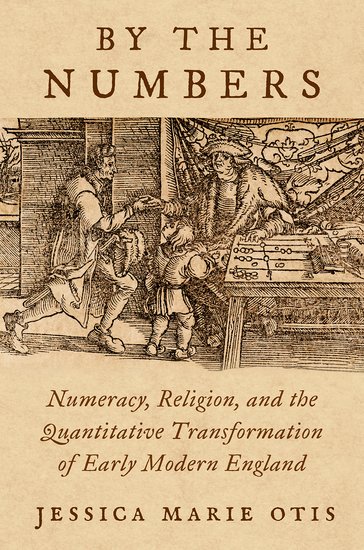By the Numbers: Numeracy, Religion, and the Quantitative Transformation of Early Modern England
- By Jessica Marie Otis
- Oxford University Press
- 264 pp.
- Reviewed by Jay Hancock
- January 29, 2024
Why ditching the tally sticks was such a bold step forward.

Steam engine entrepreneur James Watt, as responsible as anybody for upgrading the world from poor to rich, left a notebook of his work. Squiggly symbols such as “5” and “2” mark the pages. Without these little glyphs, borrowed by Europeans from medieval Arabs, Watt would not have been able to determine cylinder volumes, pressure forces, and heat-transfer rates. Isaac Newton would’ve struggled to find that gravity is inversely proportional to the square of a planet’s distance from the sun. Calculations for Antoine Lavoisier’s chemistry, Abraham de Moivre’s probability tables, and the Bank of England’s bookkeeping would have been difficult or impossible.
But before Hindu-Arabic numerals could fuel the Enlightenment and the Industrial Revolution, society had to start to think quantitatively. Jessica Marie Otis’ By the Numbers is about scribes starting to write 7 instead of VII, parish clerks counting plague deaths rather than guessing, and gamblers calculating instead of hoping and praying.
Why did some countries become wealthy after 1800? Historians argue about the relative influences of religion, climate, geography, slavery, colonialism, legal systems, and natural resources. But the key, famously shown by economist Robert Solow, who died in December, is technological innovation enabling more and more goods and services to be produced per worker and unit of capital. Innovation needs research, development, and engineering. All those require numbers and numeracy.
In the 1500s, the English began realizing that Arabic numbers, with place values and a zero symbol, are better for calculating than other methods. (Try adding up hundreds of fleeces and sacks of wool with Roman numerals.) But old habits persist. Otis goes into 16th-century account books and finds Roman notation for fixed quantities on the same pages with Arabic marks used for summing. The English used Roman numerals, tally sticks, and counting discs long after priests took up Arabic numerals to indicate the number of years since Christ was born.
People needed to learn the new “arithmetick.” But universities were busy teaching ancient Greek. Textbooks, paper, and even literacy were rare. From 1500 to 1700, however, math books and “cyphering schooles” multiplied. Lessons dropped Roman numerals and took up compound interest and decimal fractions. “Arithmetic” became synonymous with Arabic numbers.
Part of the change, explains the author, involved a retreat of religious fatalism. Once probability calculations started showing that gambling outcomes were not random, clergymen argued about whether God was still in charge. “Yes, but…” was the answer. At the same time, people got over the idea that national censuses were like King David’s sinful “numbering of the people” in the Bible. The English were already used to local parish registers. The stage was set for demography and population-data analysis.
Arabic numerals were so embedded in the commercial system by 1700 that it “would go near to ruine the Trade of the Nation” if merchants had to revert to Roman numerals, tally sticks, and other older systems, Otis quotes a Scottish physician and mathematician as saying. Like all good historians, though, she cautions readers against modernity bias, in this case assuming that Arabic notation seemed any more familiar to most early-modern Europeans than, say, Norse runes look to people today.
By the Numbers joins other important books about Western Europe’s awakening to a measurable world. These include Alfred W. Crosby’s The Measure of Reality (1997) and Ian Hacking’s The Emergence of Probability (1975), not to mention many works looking at other aspects or broader narratives of how the world changed.
Recent scholarship examines the contributions of smiths, architects, and other artisans, as well as those of dead-ender alchemists and astrologers. Otis’ research includes looking at the marginal scratchwork of 17th-century students in hundreds of surviving arithmetic textbooks. If her focus seems narrow, the material is momentous. The growth of English numeracy augured the science revolution and an economic bang that lifted billions of people from poverty.
Otis does not dwell on this. Perhaps she prefers to avoid the other anachronistic error of standing in the past and looking too far ahead. But to read By the Numbers, with its illustrations of old accounts and arithmetic textbooks, is to see the fuse being lit.
Jay Hancock writes about history and economics. His work has appeared in KFF Health News, where he worked for 10 years, the Baltimore Sun, the New York Times, and the Washington Post. His free Substack newsletter is here.

